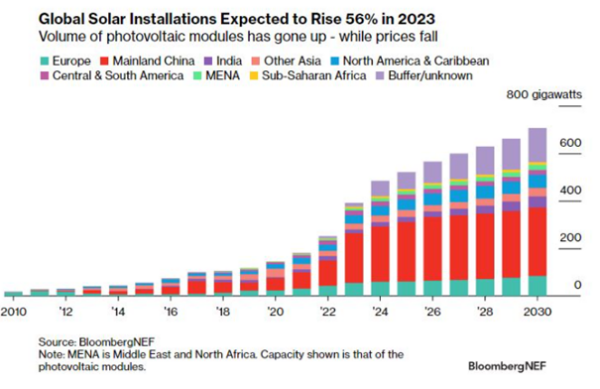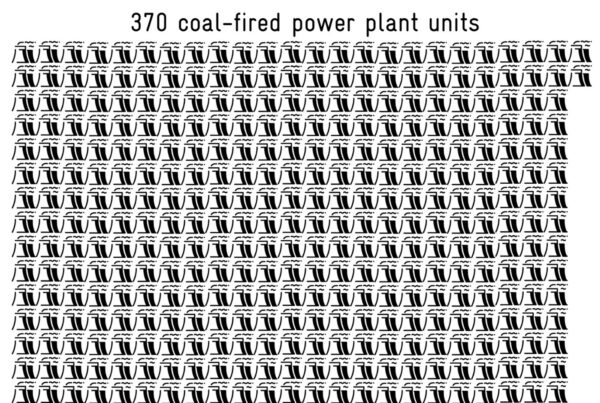Around 392 GW of photovoltaics will be added in 2023. This is more capacity than all worldwide nuclear power plants in operation in 2022, which was 371 GW cumulatively.

The global expansion of photovoltaics is impressive. We are in the midst of an energy technology revolution with major economic and ecological implications. So, what is the scale we are dealing with now and in the near future?
This is a blog in two parts: The first part, which you are reading today, analyzes the present. The second looks into the future.
According to a projection by BloombergNEF, 392 GW of photovoltaics will be added in 2023. This is more capacity than all worldwide nuclear power plants in operation in 2022, which was 371 GW cumulatively.

There are approximately 1,000 average coal-fired power plant units. The global average is 375 MW per unit. The impact of these power plants on climate change can already be surmised. It is important to note the comparison is flawed because of the different full load hours, but more on that later.
Even though these figures are impressive, they are only a snapshot. There will probably be installation figures of 1,000 GW per year – meaning 1 TW per year – before the end of this decade, and several TW per year installed in the next decade. That is what the second part of this blog will be about.
Part I of Photovoltaics-Energy Revolution – Interim Status 2023
In 1998, 57 MW of photovoltaic capacity was installed worldwide. Today, that corresponds to the output of a medium-sized solar park. At around 390 GW, annual capacity additions have increased seven thousandfold since then. The power of photovoltaics has grown in volume worldwide. We can therefore rightly speak of power photovoltaics.
Roughly 390 GW per year corresponds to a photovoltaic addition of over one GW every day. By comparison, 2004 was the first year where more than 1 GW of photovoltaic capacity was added. In 2010 this volume was added in less than a month and in 2015 it was less than every week.
| 2004 | 1 gigawatt/year |
| 2010 | 1 gigawatt/month |
| 2015 | 1 gigawatt/week |
| 2023 | 1 gigawatt/day |
The magnitude of solar photovoltaics is already considerable. The above table shows this year’s installed photovoltaic capacity is greater than the total nuclear power plant capacity. That metric is equivalent to about 1,000 average coal-fired power plant units.
But how does it look if we compare generation instead of output?
A photovoltaic plant is known to have significantly lower full load hours than coal-fired – and especially nuclear – power plants. In international 100 percent studies, the number of full load hours for photovoltaic plants averages 1570.
The 390 GW of photovoltaic capacity that will be added in 2023 will generate as much electricity as about 77 nuclear power plants of the 1000-megawatt class. It will also generate roughly 370 of the 375 MW coal-fired power plant units, taking into account lower full-load hours.

One GW per day is equivalent to the power generation capacity of a typical 1,000 MW nuclear power plant. It is also equivalent to two-and-a-half coal-fired power plant units, with the global average being 375 MW per unit.
So, for this year, new solar power will be added as a coal-fired power plant unit produces – plus the power production of a nuclear power plant every few days.
Next year there will be more installed every day, and in 2025 even more. Those amounts will be added on top of the 2023 installed.
Conclusion
The expansion of photovoltaics has reached a scale that is changing the energy industry. Naturally, it is impacting the use of fossil fuels. Photovoltaics is already a significant climate protection technology with upside potential.
We will then see what this potential resembles in the second part of the blog, which will also explore how solar power can be used at night.
The author Carsten Pfeiffer is Head of Strategy & Policy at the German Federation bne. He was one of the authors of the original German Renewable Energy Act in 2000 and is a founding member of the PV Think Tank.
The views and opinions expressed in this article are the author’s own, and do not necessarily reflect those held by pv magazine.
This content is protected by copyright and may not be reused. If you want to cooperate with us and would like to reuse some of our content, please contact: editors@pv-magazine.com.
Source from pv magazine
Disclaimer: The information set forth above is provided by pv-magazine.com independently of Alibaba.com. Alibaba.com makes no representation and warranties as to the quality and reliability of the seller and products.




